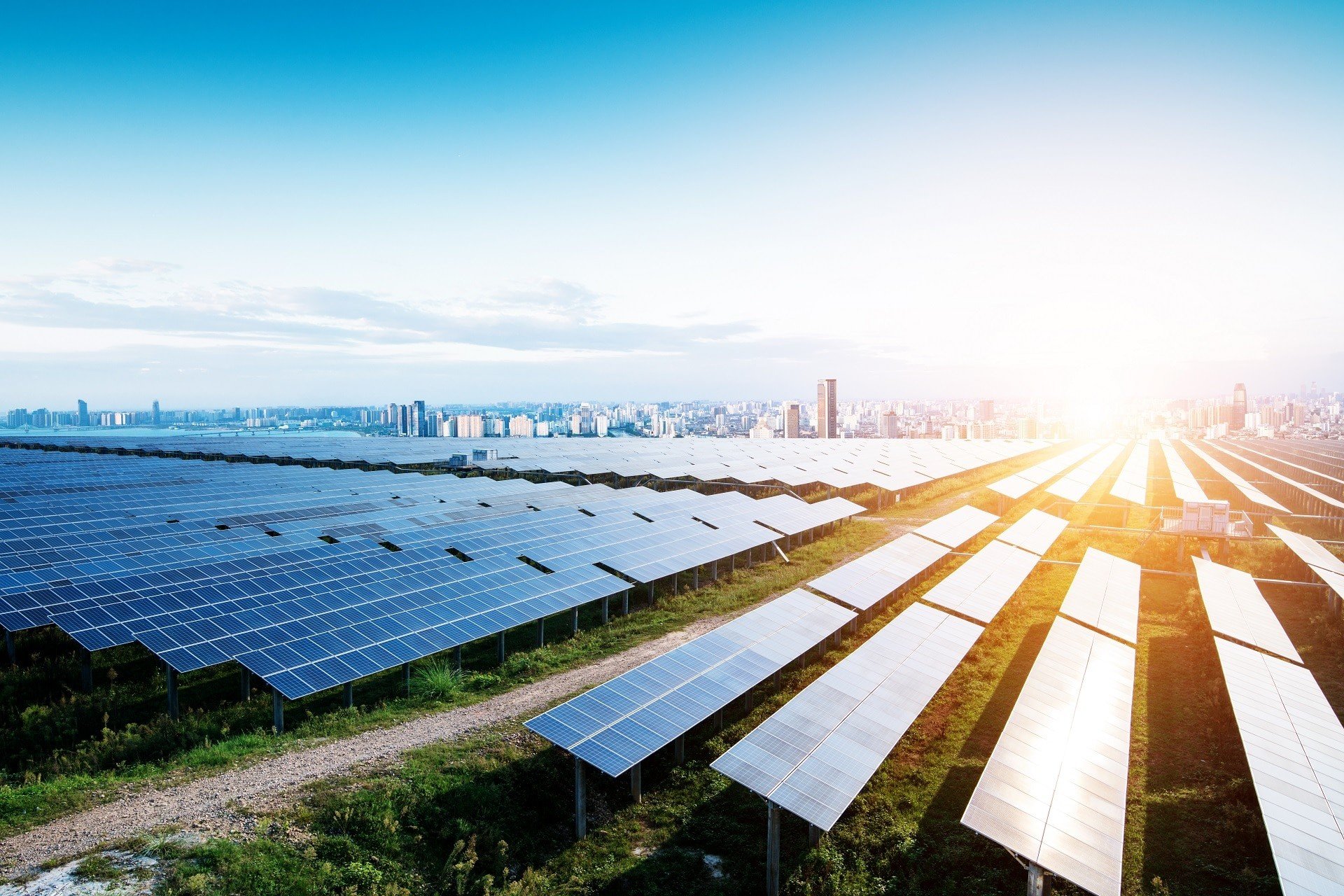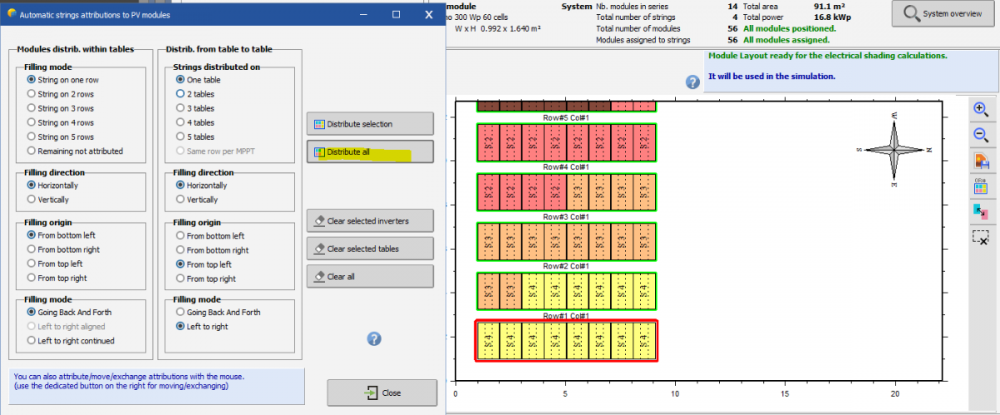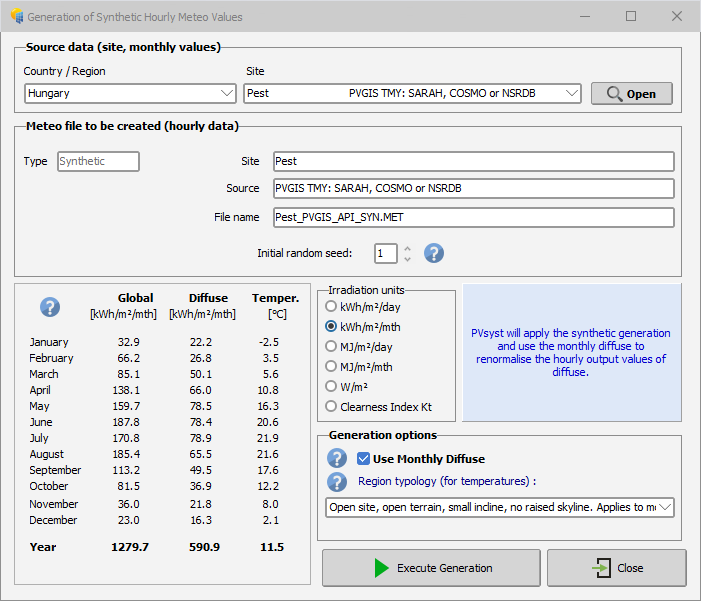-
Posts
785 -
Joined
-
Last visited
Everything posted by Michele Oliosi
-
Since version 7.2.13 you will find a bifacial performance ratio in the results summary window. This bifacial performance ratio is computed as: PRbifi = PR / (1 + (GlobBak + BackShd)/(GlobInc)) (see https://www.pvsyst.com/help/performance_ratio.htm) Note that this may not correspond to notes 1 and 2 of §3.20 in the norm IEC 61724-1:2021, since it does not include the bifaciality factor. It is instead based on a literal interpretation of the IEC 61724-1:2021 §3.20 main paragraph.
-
Since version 7.2.13 you will find a bifacial performance ratio in the results summary window. This bifacial performance ratio is computed as: PRbifi = PR / (1 + (GlobBak + BackShd)/(GlobInc)) (see https://www.pvsyst.com/help/performance_ratio.htm) Note that this may not correspond to notes 1 and 2 of §3.20 in the norm IEC 61724-1:2021, since it does not include the bifaciality factor. It is instead based on a literal interpretation of the IEC 61724-1:2021 §3.20 main paragraph.
-

PV Array Characteristics/ At Operating Condition (temp)
Michele Oliosi replied to Detroit Solar's topic in PV Components
Sorry my answer was not so clear. In the simulation, the temperature of the modules at a given hour is taken into account automatically of course. Meaning that if the modules at a given hour are hot, then they will be less efficient. (This is not affected by chosing 22 or 50.) This is what I meant by follow the one-diode model. You can find more information here https://www.pvsyst.com/help/pvmodule_corrtemper.htm The second part of my answer just meant: there is nothing special about "22°" in particular, and the choice of "22°" in particular in the project settings dialogue will not affect the simulation. It is just an example of a characteristic temperature (which in fact seems quite low in your case, maybe a choice due to low ambient temperatures). -
The correction should come out in the next or in two patches time.
-
Hi, You should consider using the "Aging tool" that you will find in the advanced simulation window. This will take into account the yearly degradation, basically what you have done in excel. It also allows to access to the degradation loss window, which will give you more information on the aging loss. Note that you can only simulate a single year with the meteonorm data you have, because what meteonorm provides (in PVsyst) is a statistics-based synthetic year, similar to a typical year, that is not a real year per se. This is indicated by the year 1990 in PVsyst. You can simulate the aging through 20 years of simulations using the meteonorm data, but the same weather data will be used every year, which is not really realistic. Real years will be subject to year-to-year variations. Therefore you should maybe look into getting real time-series data for 20 years. One option (though it may have only 12 years or so) is: Main window > Databases > Known format : choose "PVGISv5 hourly time series direct import" in the drop down menu. This will download a number of time-series files, which you can then use in the aging tool above. NB: the aging tool is not available for stand-alone systems yet. In order to use it you should redesign your system as a grid connected one. However please first consider the stand-alone system to get advanced information on the battery sizing.
-
Hi, Short answer: yes, but* PVsyst still works with a single average orientation for the transposition of the irradiance and incidence angle modifiers. However the 3D scene may contain trackers with various orientations due to topography. The shading losses will be computed accurately using the 3D scene. Finally the bifacial model is usable only if the orientation differences are small. Note that even in that case, the bifacial model will consider a fictional perfectly flat array for the backside irradiance computations.
-

Simulation based in measured global on plane. Tracking
Michele Oliosi replied to tecnun's topic in How-to
It should be possible in the current version of PVsyst. In the custom import window, you can choose the orientation when you have chosen GPlMeas as a variable: Please let us know if you have any trouble. -
Hi, The $01 is due to a bug, the correct text should indicate something along the lines of: "increase according to global irradiance on the plane of array". Basically, it means that the temperature will increase according (proportionally to) to the irradiance on your field, i.e. the power generated. The value to be inserted is the increase in degrees per 1000 W/m^2 of irradiance. The question of outdoors or indoors is really a question of temperature control. In this case the inverters are probably subject to the ambient temperature, so ambient temperature / ambient temperature with shift are both reasonable choices.
-
Hi, Thanks for the feedback. Since this would be a very big change, a complete sub-hourly simulation is not on the horizon yet. However: you can already import sub-hourly meteo data, and use it to perform a hourly simulation we are currently working on a solution allowing a partial use of the sub-hourly data to address clipping losses As johank points out there are not that many data sources just yet.
-
Hi, There seems to be a bug in the window that we need to address, we will raise a ticket on this. In the meantime the only option would be to use the automatic filling tool "Auto attribution". As long as the lower (the ones you can see) are correct, you can assume that the others are filled along the same pattern. An example below:
-
You are right, they are not really the same. We will remove the "transverse incidence angle" mention.
-
Hi, First of all: I greatly encourage you to update to our latest version. There have been many improvements and bug fixes since verion 7.2.3. Possibly you will encounter less problems on an updated version. Second, the subarrays on the inverter SUN2000-215KTL-H3 seem to be okay, however, you first have to correct the issue (written in red) with the subarrays on the SUN2000-185KTL-H1. Indeed this needn't be a blocking message, and we will raise a ticket to address this issue.
-

Manually changing meteo data not working CMSAF
Michele Oliosi replied to Niels's topic in Meteo data
Hi, You need to regenerate a new .MET file that corresponds to the monthly data (see the example screenshot below). In the site drop-down menu, you should find the site you have saved with modified values. You should then use the new .MET file for the simulation. -

PV Array Characteristics/ At Operating Condition (temp)
Michele Oliosi replied to Detroit Solar's topic in PV Components
Hi, During the simulation, PVsyst considers the current temperature of the PV modules, which may be any value. The production takes into account these temperatures differences based on the one-diode model. The specific value at operating conditions (for you 22°) is just an example value, it doesn't really affect the simulation per se. -

Split GlobBak into GlobBakInc and GlobBakEff
Michele Oliosi replied to johank's topic in Suggestions
Hi Johank, Thanks for the suggestion, we'll be looking into that.! -
I have added this feature to our ticketing system to be evaluated. Thanks for the feedback !
-
Hi, The easiest way would be to do a bifacial simulation. Whenever the bifacial model is used, you have access to the output variable: global on ground, which computes the average irradiance on the ground taking into account the shading from regular rows of tables or trackers. You can choose this variable in the hourly variables.
-
There are basically two ways to do this. First of all you want to import your weather data into PVsyst. Then the easiest way is to make a PVsyst simulation with an output file. You can do so by going to the "advanced simulation" menu. There please define the "Output file". Among the outputs you can choose GlobInc. Once you are done, you should launch a simulation from the same "advanced simulation" window. The second way is to use the "meteo tables and graphs" window, which you get either from the "Databases" menu, or from a project by opening the meteo file. From there, you have a series of tools to display the hourly data, including the Global irradiance on a tilted plane (so you have to choose a plane tilt and azimuth). You can export the data after showing it in a graph or table.
-

Calculating mismatch in trackers with different axis tilts
Michele Oliosi replied to Bruno Lima's topic in Simulations
Yes the "mixed orientation" option can be used with two orientations only. In the system window you can put them on the same inverter only if you put them on separate MPPT inputs. If not, then yes I would suggest to reduce the number of orientations to 2. Indeed, it may give a rough approximation of your output. You can also create the tables first, and then use the "orientation management" tool of the 3D scene. This will allow you to detect orientations automatically, with different tolerances. If you bring them down to two there, you may keep your 3D scene as is. -
Are you using a cloud service on the folder you are storing your workspace / CSV file ? (e.g. dropbox, google drive, ...) If so please deactivate the synchronization before saving the file. Another option would be to save the files locally instead of a cloud-shared folder.
-

Sandia Model Database no longer supported?
Michele Oliosi replied to linkeshd's topic in PV Components
Hi linkeshd and thanks for the feedback. We will update the link in the help. When using the Sandia model for a model out of the database, one will apply the "default" parameters: b₀ = 1 , b₁ = -0.002438 , b₂ = 0.003103 , b₃ = -0.0001246 , b₄ = 0.0000001211 , b₅ = -0.00000000136 Of course it is generally incorrect to use these values. -

Calculating mismatch in trackers with different axis tilts
Michele Oliosi replied to Bruno Lima's topic in Simulations
Hi Bruno, No, for trackers we perform the transposition using only a single orientation value. There may be a way to compute this mismatch in some future update of PVsyst, but for now it would be quite difficult. You may get a rough estimate of the mismatch by using the fixed tilt option, but it probably requires to be quite careful. -
Hi shubham, Yes you can do this. You can use the "multiple orientations" option in the "orientation" window, which lets you use up to 8 fixed tilt orientations. Then you can just choose a tilt value = 90° when you need it.
-
The shed to shed slope, is the slope in the front-back direction of your tables, usually NS direction. Your tables therefore all have the same orientation (tilt and azimuth) but are at different heights due to the slope. In the case of the baseline slope, we consider a slope along the bottom of the table, usually EW direction. Your tables effective orientation will be changed, since the orthogonal vector to your table surface does not correspond to the original nominal tilt and azimuth.





